Armor Materials Market Size
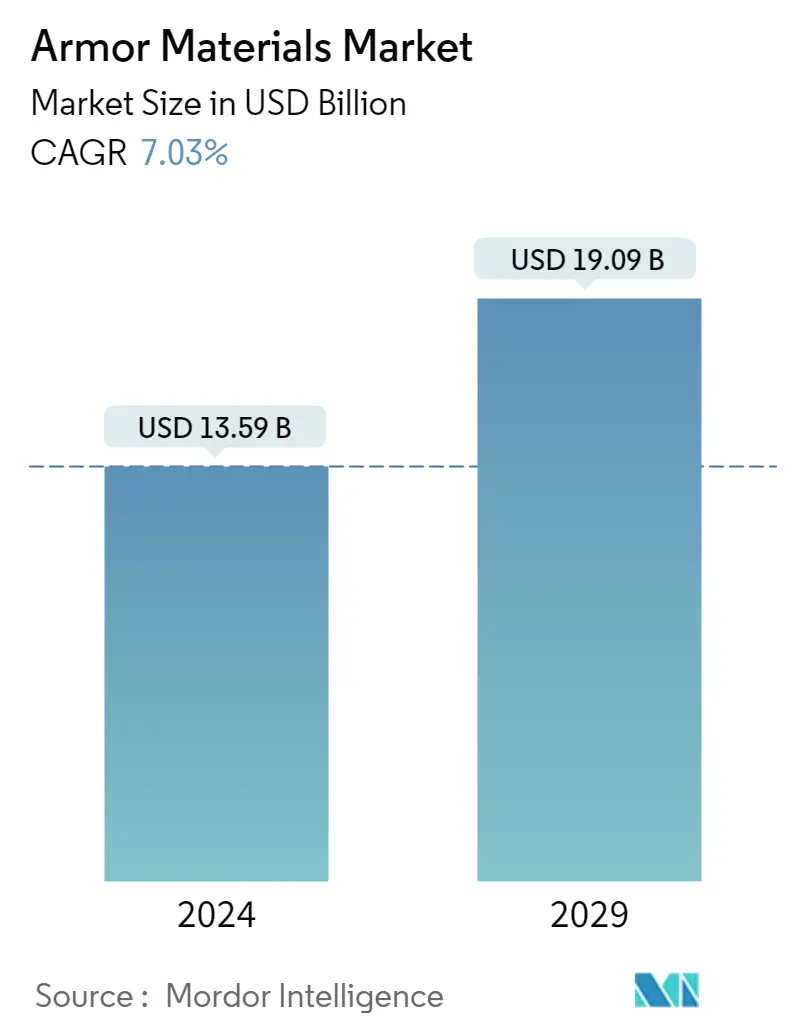
| Study Period | 2019 - 2029 |
| Market Size (2024) | USD 13.59 Billion |
| Market Size (2029) | USD 19.09 Billion |
| CAGR (2024 - 2029) | 7.03 % |
| Fastest Growing Market | North America |
| Largest Market | North America |
Major Players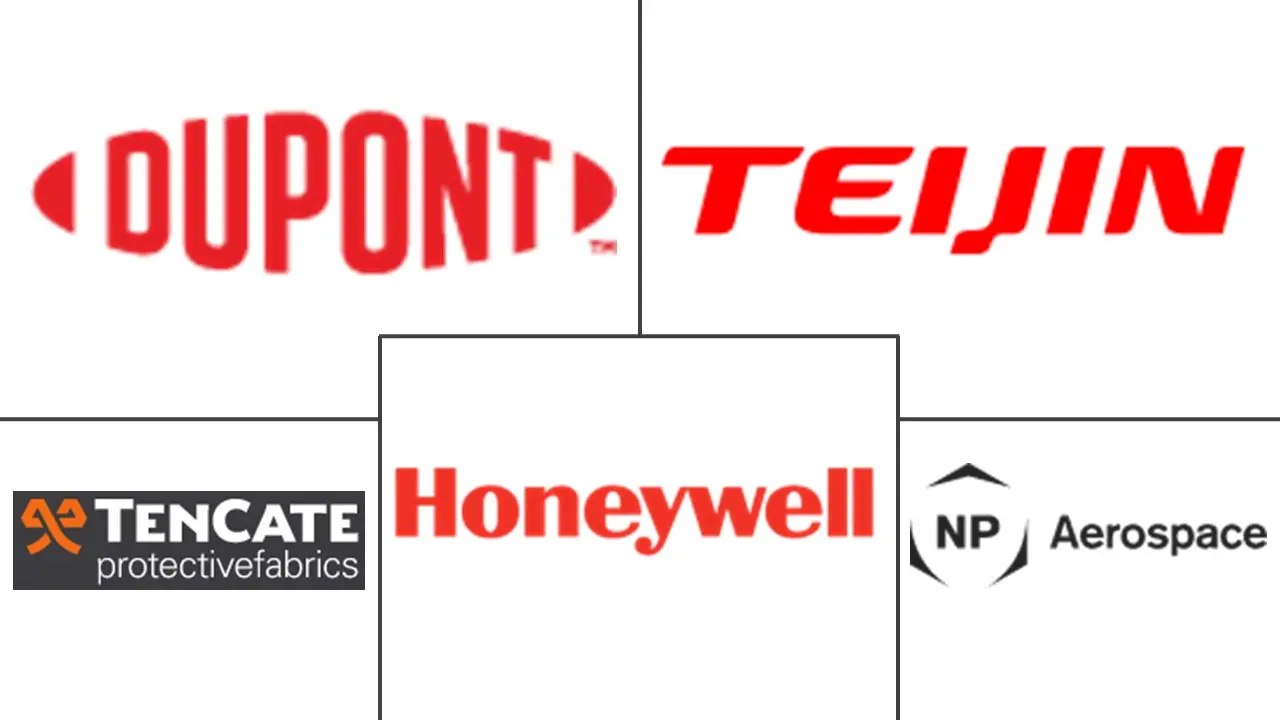
*Disclaimer: Major Players sorted in no particular order |
Armor Materials Market Analysis
The Armor Materials Market size is estimated at USD 13.59 billion in 2024, and is expected to reach USD 19.09 billion by 2029, growing at a CAGR of 7.03% during the forecast period (2024-2029).
Due to COVID-19-related lockdown restrictions, many manufacturing industries came to a halt. However, several armor manufacturing companies, such as TenCate Advanced Armor and NP Aerospace, continued to run their production by re-organizing, ensuring the safety of employees, and following government regulations to provide continuous supply to customers. Such unhindered production boosted the armor materials market during the pandemic.
- Over the short term, the development of body armor and advanced weapons and increasing homeland security concerns are major factors driving the growth of the market studied.
- However, high cost of production of defense products are likely to restrain the growth of the studied market.
- Nevertheless, increasing defense budget and rising military modernization programs are likely to create lucrative growth opportunities for the global market soon.
- North America dominated the market, holding the largest share, and is expected to dominate the market during the forecast period.
Armor Materials Market Trends
Body Armors Application expected to lead the Market
- Homeland security concerns have made it necessary for all countries to have well-trained defense forces. The requirement for army training is increasing owing to the increasing bilateral tensions between nations.
- For homeland security, soldiers are meant to fight, for which they require weapons, vehicles, and body shields to protect them. China had the world's largest armed forces in terms of active duty military personnel in 2022, with over 2 million active soldiers. The top five largest armies were India, the United States, North Korea, and Russia.
- Russia spent around USD 86.4 billion on its military expenses in 2022, having increased its spending by 31 percent over the previous year.
- Wearing body armor is almost a common practice, and in many instances, mandatory among military personnel and special forces, as they help reduce fatalities in military environments.
- During wars, soldiers have to wear body armor and carry weapons, such as guns, grenades, etc. Hence, these are to be made available to military personnel during wars. Every year, more individuals join the army, creating further demand for armor and weapons.
- Furthermore, Philippines is planning to modernize its military over the next decade and has allocated PHP 25 billion (~USD 447.55 million) for the same. Under this program, the Armed Forces of the Philippines (AFP) is expected to receive more night-capable attack helicopters and fast boats, along with more body armor, rifles, and helmets.
- Additionally, according to the Department of Defence Production (India), in the financial year 2022, the export value of defense equipment from India reached INR 128.2 billion (~USD 1.63 billion).
- According to the Union Budget 2022-23 of India, 25% of the defense R&D budget has been designated for private industry and start-ups, paving the door for the development of innovative defensive technology in India.
- The Spanish government has announced its decision to increase its military expenditure to approximately EUR 18 billion (~USD 18.97 billion) by 2024.
- Owing to all the above-mentioned factors, the body armors segment is expected to dominate the market during the forecast period.
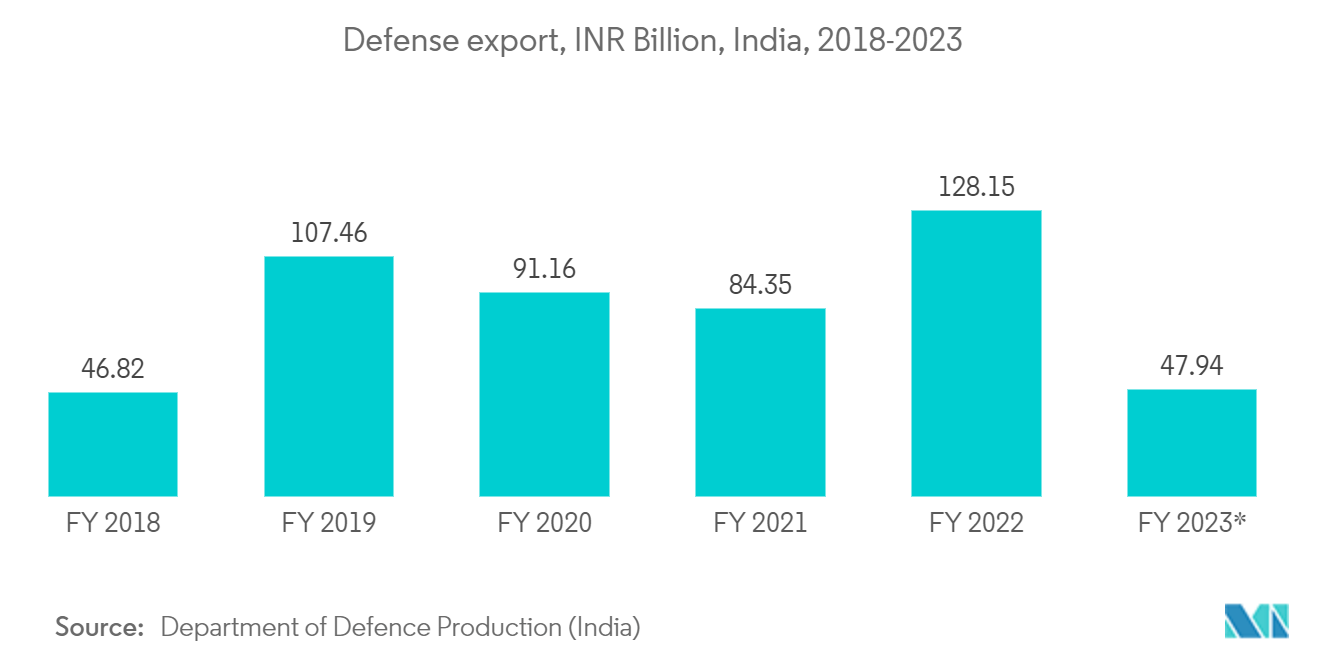
North America to dominate the Market
- North America dominated the global market in terms of market share. The United States is one of the largest consumers of armor materials globally.
- This is majorly owing to the rising homeland security concerns due to terrorism. The United States has the highest military expenditure and has the largest military force globally.
- According to the US Army's most recent budget document, a total of 504 units of fire vehicles are expected to be procured with 260 being ordered through 2022-2027.
- Additionally, the US Army and BAE Systems are collaborating to find ways to speed up manufacturing of the new Armoured Multi-Purpose Vehicle, which would allow the service to replace aging M113 armored troop carriers more swiftly.
- Furthermore, the emerging geopolitical and bilateral tensions between the major nations and the increasing terrorist activities lead to the increasing procurement of armor materials to manufacture defense equipment.
- The United States also struck a significant deal with Saudi Arabia for arms deal sales, along with the sale of F-35 combat aircraft.
- Lockheed Martin, the largest domestic fighter jet manufacturer, announced its decision to nearly triple its annual production to more than 160 jets by 2023.
- The US army also announced its plans to spend about USD 1.4 billion on manufacturing lightweight tanks over the forecast period.
- These factors will likely drive the demand for armor materials in North America over the forecast period.
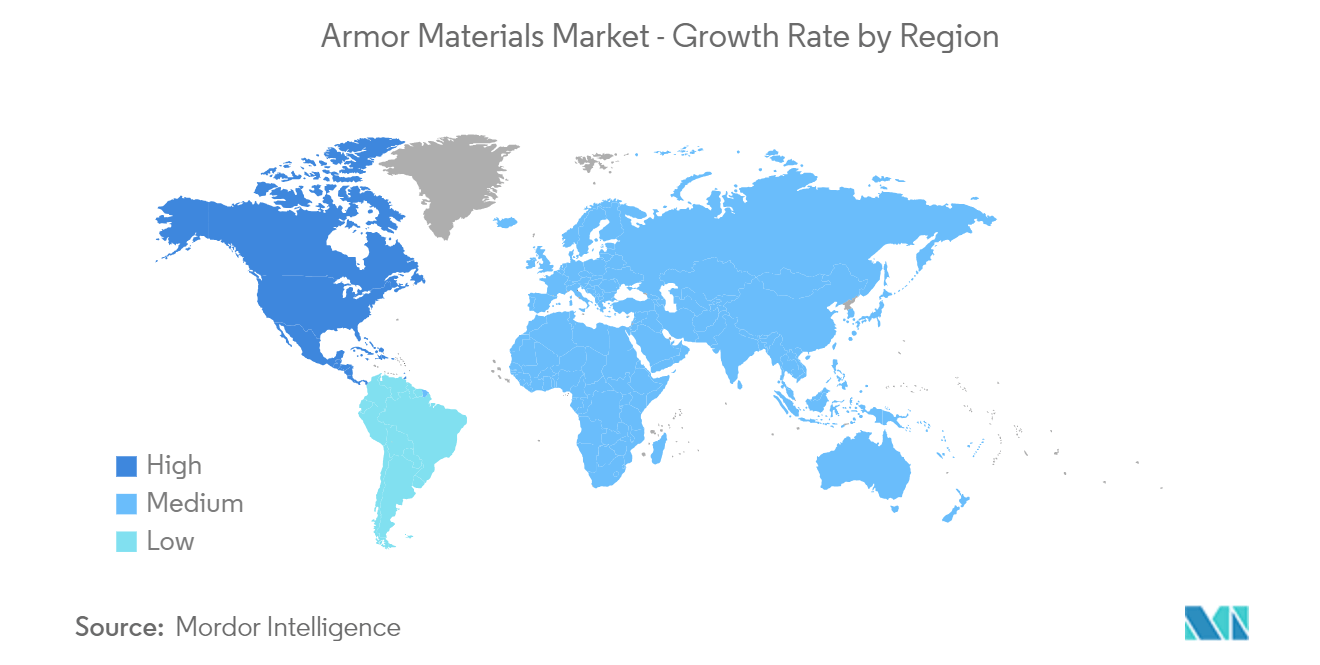
Armor Materials Industry Overview
The armor materials market is consolidated in nature. The major players include DuPont, Teijin Aramid B.V., TenCate Protective Fabrics, NP Aerospace, and Honeywell International Inc, among others (not in any particular order)
Armor Materials Market Leaders
-
DuPont
-
Teijin Aramid B.V.
-
TenCate Protective Fabrics
-
NP Aerospace
-
Honeywell International Inc
*Disclaimer: Major Players sorted in no particular order
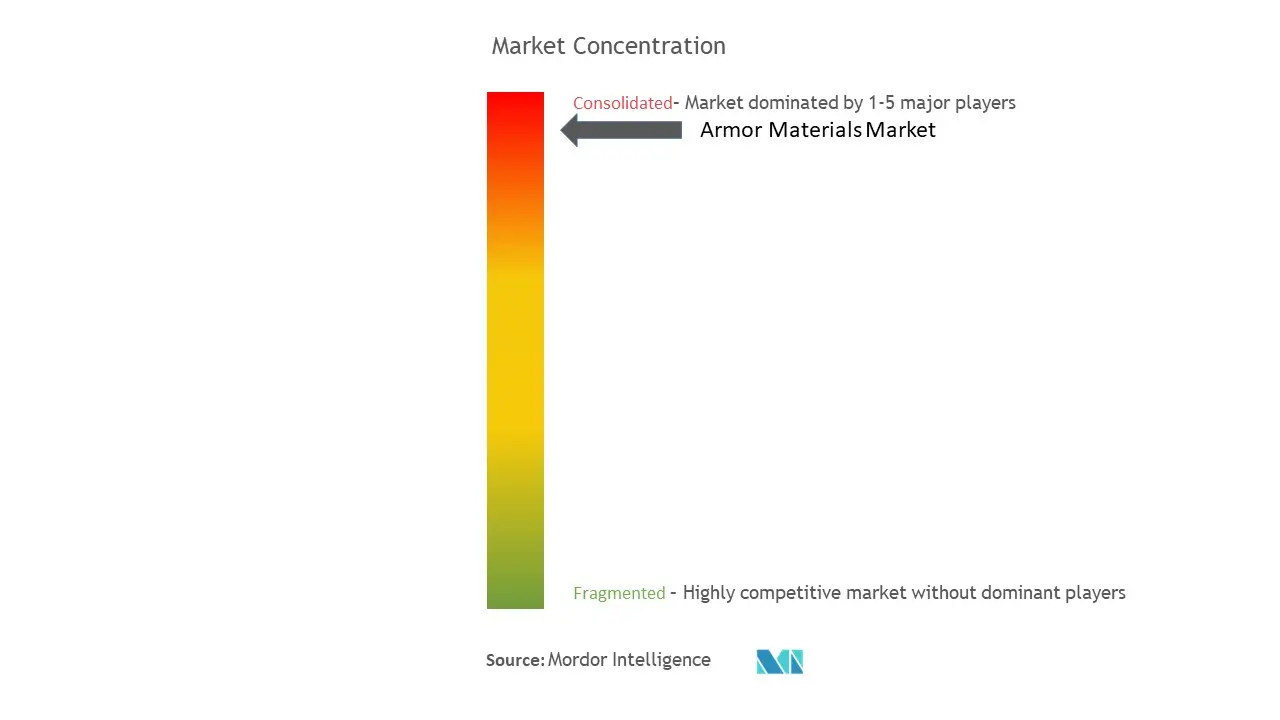
Armor Materials Market News
- In April 2023, DuPont launched its innovative products Kevlar, and EXO aramid fibre, which is developed to serve endless applications in body armour where performance and protection is required in the midst of intense and demanding conditions. These products offer an unprecedented combination of lightness, flexibility and protection.
- In April 2023, NP Aerospace announced the expansion of its two separate business units namely NP Aerospace Vehicle Systems, Services and Spares and NP Aerospace Composites and Armour Systems to support the company's growth. The company will support the growth of the company's personal protection, platform armour, and commercial composites product lines through NP Aerospace's Composites and Armour Systems business unit.
Armor Materials Market Report - Table of Contents
1. INTRODUCTION
- 1.1 Study Assumptions
- 1.2 Scope of the Study
2. RESEARCH METHODOLOGY
3. EXECUTIVE SUMMARY
4. MARKET DYNAMICS
-
4.1 Drivers
- 4.1.1 Development of Body Armor and Advanced Weapons
- 4.1.2 Increasing Homeland Security Concerns
- 4.1.3 Other Drivers
-
4.2 Restraints
- 4.2.1 High Cost Of Production Of Defense Products
- 4.2.2 Others
- 4.3 Industry Value Chain Analysis
-
4.4 Porter's Five Forces Analysis
- 4.4.1 Bargaining Power of Suppliers
- 4.4.2 Bargaining Power of Buyers
- 4.4.3 Threat of New Entrants
- 4.4.4 Threat of Substitute Products and Services
- 4.4.5 Degree of Competition
5. MARKET SEGMENTATION (Market Size in Value)
-
5.1 Product Type
- 5.1.1 Metal and Alloy
- 5.1.2 Ceramic and Composite
- 5.1.3 Para-aramid Fiber
- 5.1.4 Ultra-high-molecular-weight Polyethylene
- 5.1.5 Other Product Types (Including Fiber Glass, etc.)
-
5.2 Application
- 5.2.1 Aerospace
- 5.2.2 Body Armor
- 5.2.3 Civil Armor
- 5.2.4 Marine Armor
- 5.2.5 Vehicle Armor
-
5.3 Geography
- 5.3.1 Asia-Pacific
- 5.3.1.1 China
- 5.3.1.2 India
- 5.3.1.3 Japan
- 5.3.1.4 South Korea
- 5.3.1.5 Rest of Asia-Pacific
- 5.3.2 North America
- 5.3.2.1 United States
- 5.3.2.2 Canada
- 5.3.2.3 Mexico
- 5.3.3 Europe
- 5.3.3.1 Germany
- 5.3.3.2 United Kingdom
- 5.3.3.3 France
- 5.3.3.4 Italy
- 5.3.3.5 Rest of Europe
- 5.3.4 South America
- 5.3.4.1 Brazil
- 5.3.4.2 Argentina
- 5.3.4.3 Rest of South America
- 5.3.5 Middle East and Africa
- 5.3.5.1 South Africa
- 5.3.5.2 Saudi Arabia
- 5.3.5.3 Rest of Middle East and Africa
6. COMPETITIVE LANDSCAPE
- 6.1 Mergers and Acquisitions, Joint Ventures, Colaborations and Agreements
- 6.2 Market Share (%)**/Ranking Analysis
- 6.3 Strategies Adopted by Leading Players
-
6.4 Company Profiles
- 6.4.1 3M
- 6.4.2 ARMORSOURCE, LLC.
- 6.4.3 ATI
- 6.4.4 CeramTec GmbH
- 6.4.5 CoorsTek Inc.
- 6.4.6 DSM
- 6.4.7 DuPont
- 6.4.8 Honeywell International Inc.
- 6.4.9 HYOSUNG
- 6.4.10 JPS Composite Materials
- 6.4.11 TenCate Protective Fabrics
- 6.4.12 Morgan Advanced Materials
- 6.4.13 NP Aerospace
- 6.4.14 PPG Industries, Inc.
- 6.4.15 SAFEGUARDARMOR.COM
- 6.4.16 Saint-Gobain
- 6.4.17 Schunk Carbon Technology
- 6.4.18 Tata Steel
- 6.4.19 Teijin Aramid B.V.
- *List Not Exhaustive
7. MARKET OPPORTUNITIES AND FUTURE TRENDS
- 7.1 Increasing Defense Budget
- 7.2 Rising Military Modernization Programs
Armor Materials Industry Segmentation
An armor is a defensive covering used to prevent damage against damage inflicted by humans or projectiles, as well as damage caused by a hazardous environment or operation. Personal armor is used to protect soldiers and war animals. Vehicle armor is used on armored fighting vehicles and warships. The armor materials market is segmented by product type, application, and geography. By product type, the market is segmented into metal and alloy, ceramic and composite, para-aramid fiber, ultra-high-molecular-weight polyethylene, and other product types. By application, the market is segmented into aerospace, body armor, civil armor, marine armor, and vehicle armor. The report also covers the market size and forecasts for the armor materials market in 15 countries across major regions. For each segment, the market sizing and forecasts have been done on the basis of revenue (USD).
| Product Type | Metal and Alloy | |
| Ceramic and Composite | ||
| Para-aramid Fiber | ||
| Ultra-high-molecular-weight Polyethylene | ||
| Other Product Types (Including Fiber Glass, etc.) | ||
| Application | Aerospace | |
| Body Armor | ||
| Civil Armor | ||
| Marine Armor | ||
| Vehicle Armor | ||
| Geography | Asia-Pacific | China |
| India | ||
| Japan | ||
| South Korea | ||
| Rest of Asia-Pacific | ||
| Geography | North America | United States |
| Canada | ||
| Mexico | ||
| Geography | Europe | Germany |
| United Kingdom | ||
| France | ||
| Italy | ||
| Rest of Europe | ||
| Geography | South America | Brazil |
| Argentina | ||
| Rest of South America | ||
| Geography | Middle East and Africa | South Africa |
| Saudi Arabia | ||
| Rest of Middle East and Africa |
Armor Materials Market Research FAQs
How big is the Armor Materials Market?
The Armor Materials Market size is expected to reach USD 13.59 billion in 2024 and grow at a CAGR of 7.03% to reach USD 19.09 billion by 2029.
What is the current Armor Materials Market size?
In 2024, the Armor Materials Market size is expected to reach USD 13.59 billion.
Who are the key players in Armor Materials Market?
DuPont, Teijin Aramid B.V., TenCate Protective Fabrics, NP Aerospace and Honeywell International Inc are the major companies operating in the Armor Materials Market.
Which is the fastest growing region in Armor Materials Market?
North America is estimated to grow at the highest CAGR over the forecast period (2024-2029).
Which region has the biggest share in Armor Materials Market?
In 2024, the North America accounts for the largest market share in Armor Materials Market.
What years does this Armor Materials Market cover, and what was the market size in 2023?
In 2023, the Armor Materials Market size was estimated at USD 12.70 billion. The report covers the Armor Materials Market historical market size for years: 2019, 2020, 2021, 2022 and 2023. The report also forecasts the Armor Materials Market size for years: 2024, 2025, 2026, 2027, 2028 and 2029.
Armor Materials Industry Report
Statistics for the 2024 Armor Materials market share, size and revenue growth rate, created by Mordor Intelligence™ Industry Reports. Armor Materials analysis includes a market forecast outlook to 2029 and historical overview. Get a sample of this industry analysis as a free report PDF download.



